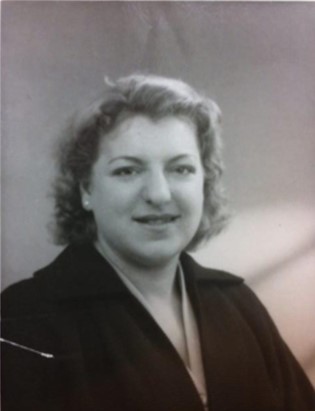Victoria PISANTI
We are a group of 9th grade students from the Blés d’Or secondary school; Steven, Evan, Matteo, Roméo and Gaétan. During this school year, we have had the opportunity to work on the Convoy 77 project. This is an educational project that aims to retrace the lives of the people deported on the last transport that left Drancy on July 31, 1944, hence the number. In this case, the person we chose was Victoria Pisanti, while the rest of the class worked on her two sisters and her father, all of whom were deported on the same convoy. We were able to retrace Victoria’s story by watching testimonies on the Shoah Memorial website (in particular the testimony of Victoria’s sister, Béqui), by analyzing archived material provided by the association and by visiting the Drancy camp memorial.
The photo below shows the Pisanti family: Fortunée on the left, Albert on the right with his arm around Victoria, Louise in front of her mother and Béqui kneeling down at the front.

My name is Victoria Pisanti and I was born on March 3, 1927 in the 12th district of Paris. My mother’s name was Fortunée Tchiproul and my father was Albert Pisanti. My parents were Turkish and both came to France in response to increasing anti-Semitism in Turkey. My mother and father were second cousins. He was an electrician and she was a seamstress. I had two sisters, Louise, who was born in 1930 and Bequi, who was born in 1925. When I was growing up, I lived at 49 rue du moulin Vert in the 14th district of Paris. I am Jewish but during my childhood I had no religious education. I went to a public school and had a happy, normal and carefree childhood.
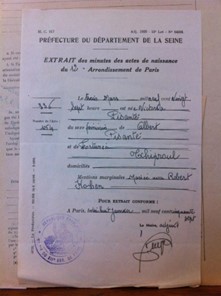
This is Victoria Pisanti’s birth certificate, from which we found out when and where she was born.
In 1939, when it was announced that France was about to go to war with Germany, my father began to worry about our future because it was said that the Germans were anti-Semitic. When the armistice was signed in June 1940, the relief was short-lived since shortly afterwards the Germans occupied France. I used to see them in the streets in Paris. I continued to go to school with Louise but the various anti-Semitic restrictions interfered with our daily lives. In October 1942, when they handed out and told us to wear the Jewish yellow star, I felt discriminated against. My classmates looked at me differently and I was very sad.
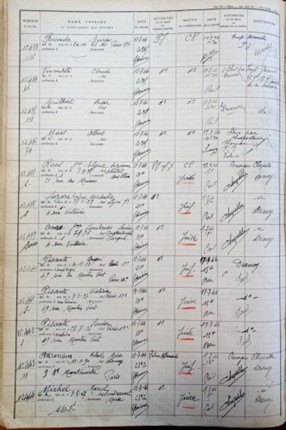
This record helped us to find out about Victoria’s background, her work and where she was living when she was arrested.
During the occupation, my family and I often went into hiding in Villepinte where my mother had an apartment about 50 yards from her sister’s. On July 7, the police arrested my father at work. And on July 12, even though we were hiding in my aunt’s apartment in Villepinte, it was my sisters’ and my turn to be arrested. We were scared because our mother wasn’t there.
After spending two nights in a detention center, we were transferred to Drancy camp on July 17, 1944, where we met up with our father. We were all as scared as ever. Drancy was a huge U-shaped building and most of the people interned there were Jews. As my mother had not been arrested, she often went to a bar that we could see from our “room” through a wire fence. This was very risky because she could have been arrested at any moment. One night we were asked to pack up all our belongings because we were leaving the next day. We had to sleep at one end of the building. Early the next morning we were taken by bus to the Bobigny railroad station. We had no idea where we were going. We were loaded into cattle cars, each with a bucket for us to relieve ourselves. The smell was unbearable and we were tired and hungry. The journey lasted two days and three nights. When we arrived, the guards made us get off the train and then divided us into two groups according to our gender. I was taken into the camp, and at that point I lost sight of my family. I was then taken to a room where we were all shaved and tattooed with a deportee number that we had to memorize in German. My sister Bequi and I were selected to work. We never saw Louise or our father again.

Photo of the entrance to Birkenau
At the end of October, we were transferred to the Kratzau camp in Czechoslovakia. It was very cold there, and our clothes were too big and not warm enough. We were still just as hungry and we were seen as objects to be exploited without mercy. The rules were much more stringent than they had been in Auschwitz. If we were sick, we had to hide it so that we were not sent to the so-called hospital, because people who went there were seldom seen again. This place frightened us.
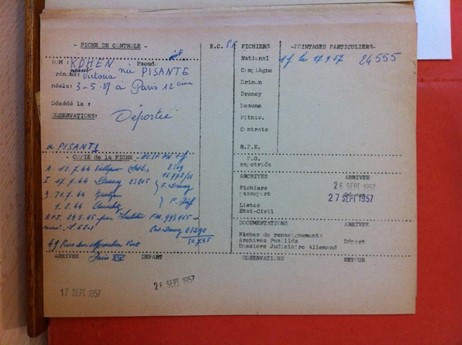
This record enabled us to retrace the details of Victoria’s deportation and transfers, starting with the date that she was arrested in Villepinte.
One winter morning, I was surprised to see that it was daylight when I woke up. Together with the other women in the block, I went outside, only to discover that the guards had disappeared. A feeling of astonishment mixed with happiness came over me. We were speechless: the Germans had all gone. Soon afterwards, we saw the tanks of the Red Army approaching and then the soldiers came and took care of us. It was May 8, 1945. We were finally reunited with our mother at the Lutetia hotel on May 24, 1945. It was a very intense and emotional moment.
My sister and I were very sad because when we returned to France, we discovered that our father and our little sister Louise were dead. They were probably selected to be killed as soon as they got off the train, as were so many other people. We returned home tired and sick. We needed medical care and our bodies had to learn how to eat again: we could only eat pureed food for the first few weeks. I slowly rebuilt my life, continued to work as a seamstress and later married Robert Kohen. Life gradually returned to normal, but there were still ripples of anti-Semitism. For the rest of my life, I never really felt at peace
The Pisanti family tree
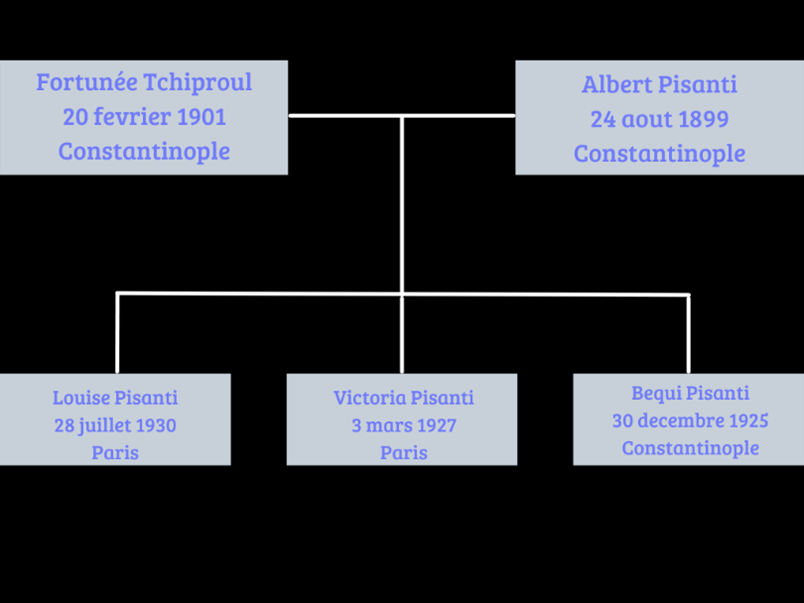
Sources
- Archived records provided by Convoy 77.
- Witness statements from Béqui Pisanti, Marceline Loridan and Yvette Levi, available on the Shoah Memorial website.
- Short biographies available on the Yad Vashem website.
- Books: Simone Veil – Jeunesse au temps de la Shoah; Ginette Kolinka – Retour à Birkenau; Henri Borlant – Merci d’avoir survécu and Ida Grinspan – J’ai pas pleuré.
- Photos taken at the Shoah Memorial in Drancy


 Français
Français Polski
Polski